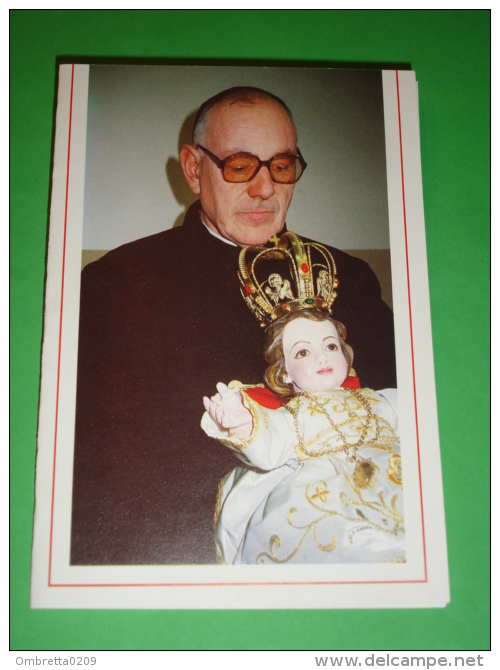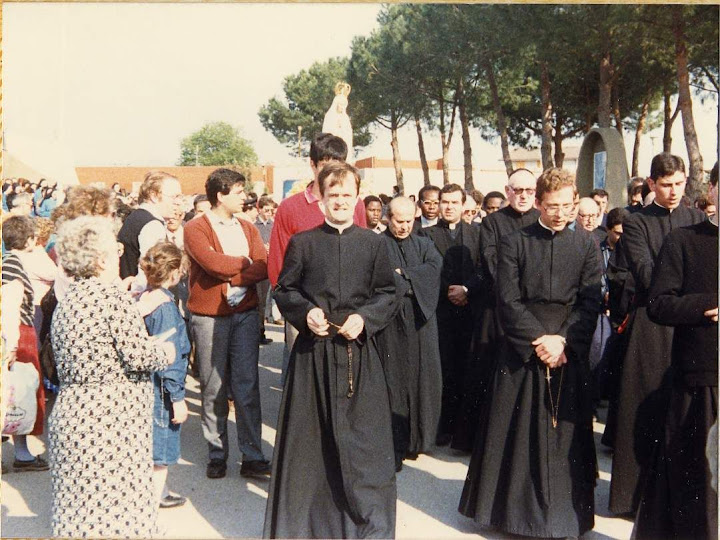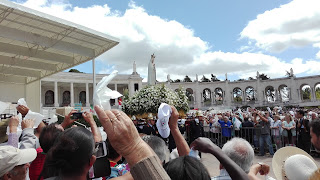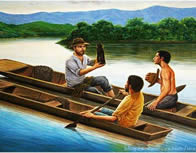FATHER GINO, APOSTLE OF OUR LADY OF FATIMA
In Italy there now lives a brother of the Congregation of the Oblates of the Virgin Mary, who has helped many people to know how to apply the Message of Fatima in their lives in the Twentieth Century. His name is Brother Gino, and in the following article we quote him many times when he talks about living the Message of Fatima. In addition to the edifying effect of his spiritual counsels and the example of his holy life, God seems to be teaching us another thing through the special gifts He has given this brother.
People who have a knowledge of theology and who have known Brother Gino agree that God has a special purpose for giving us this Brother in the Twentieth Century. One of the signs of the times today is the prevalence of atheism and materialism, where people live as though there were no God and where at times it seems whole nations forget that there is a God Who created all things and to Whom we are answerable for what we do. By giving to the Church in the Twentieth Century such a holy man, God seems to be showing us that Christ is real, the Catholic Faith is real, and that Christ is still with us. God hasn't forgotten us even though so many of us forget Him.
Brother Gino has a great devotion to Our Lady of Fatima, and he has built a large shrine in Her honor at San Vittorino, near Rome, Italy. He sees the importance of the Fatima Message in our times, and explains (as Pope John Paul II says), Fatima is a reaffirmation of the Gospels. Our Lady of Fatima told us how to apply the teachings of Christ to our lives in the Twentieth Century.
Brother Gino was born on July 7, 1932 in a small farming town called Gambassi, near Florence, in Italy. He is the eldest child of Angelo and Blandina Burresi. From an early age, as his mother noticed, he showed great charity for others and an unusual degree of devotion to God and the Blessed Mother. At the early age of 14 he joined the Congregation of the Oblates of the Virgin Mary, and made his perpetual vows in 1956.
Saved American Soldiers
During World War II there was much crisis and sorrow for Italy, as there was for the rest of the world. Brother Gino was about nine years old at the time. Previous to the takeover by the American soldiers, Brother Gino helped to save the lives of several American soldiers who had been taken prisoner by certain German soldiers who intended to kill them.
Gino said to his father, "Those Germans intend to kill the Americans. It is not right to kill those many young men. You must free them."
Angelo Burresi replied to his boy, "It is too dangerous. The fence which surrounds the prison camp is electrified."
Gino said, "Father, do not worry. I will pray to the Blessed Mother. You go ahead and free those soldiers. Nothing will happen to you."
The boy Gino kept insisting until Angelo Burresi, together with his cousin, went to see what they could do. They cut the wire and helped the young prisoners to escape.
Angelo next called several Italian families together and came to an understanding with them that the American soldiers would be kept hidden from the Germans. These families would see that sufficient food was given to the Americans. Gino was assigned to represent the Burresis by carrying food to the American young men. It was necessary to pass the German soldiers to reach the hiding Americans, and at times Gino had much difficulty, as he had to make several river crossings.
His mother Blandina Burresi had taught him to pray in the following way when he was afraid: "Jesus, Mary, Joseph, accompany me along the way." And she had given him a Rosary and taught him to say it. Armed with these prayers Gino passed safely through the Germans and brought food to the American soldiers in their place of hiding. This whole incident was very heroic, as all who were involved in freeing, hiding, and feeding the American soldiers may well have been shot by the German soldiers if they were discovered.
Early Years as a Brother
On December 10, 1946, when Gino was fourteen years old, he entered the Oblates of the Virgin Mary as an aspirant. On February 13, 1950, he entered the novitiate. He wanted to be a brother. Since he was very talented and intelligent, his parents and superiors didn't understand why he didn't aspire to be a priest. Brother Gino was trying to do God's will above all, and he thought God wanted him to be a brother. He was happy to do the humble work of a brother, teaching catechism, visiting the sick, helping the poor, and looking after the cleaning of the churches where he was working at different times. After many years Brother Gino resumed his studies for the priesthood. In 1979 he was ordained a deacon, which is the major order which precedes ordination to the priesthood. Brother Gino, by his prayers and example, has drawn many young men to come to the Oblate Seminary at Our Lady of Fatima's shrine at San Vittorino.
The Oblates of the Virgin Mary
The Oblates of the Virgin Mary is a Congregation founded by Venerable Pio Bruno Lanteri, a humble Italian priest who lived in the troubled times during and after the French Revolution. When Bruno Lanteri was just a little boy of four years old, his mother died, and his father was left looking after a large family of young children. Bruno's father took him to the parish church, and there before the altar of Our Lady he said to his son: "You no longer have a mother here on earth. From now on, the Blessed Virgin will be your Mother. Love Her as your true Mother."
When Bruno Lanteri was in Turin studying for the priesthood, everywhere there was influence of the false doctrines of the Jansenists. Jansen taught in effect that human nature was completely corrupted by original sin and that we don't have a free will and he taught the false doctrine of predestination. These heresies caused people to lack trust in God's mercy and goodness. Heated controversies over the false doctrines occurred in theological circles. Bruno Lanteri however continued in his devotion to the Mother of God, who, as the Catholic Church says, is the destroyer of all heresies, and Bruno's prayers were answered, and he was saved from the errors of the Jansenists. Just before receiving the diaconate, Bruno Lanteri consecrated himself in a special way into the hands of the Blessed Virgin Mary (in 1781), in a similar manner as the offering of St. Louis de Montfort.
While studying for the priesthood, Bruno Lanteri worked among the poor in Turin. As a priest, he constantly encouraged others to have loyalty to the Holy Father. "It is a question of the unity, of the center, of the foundation of the faith," he said. When Pope Pius VII was imprisoned at Savona (1809 -1812), then at Fontainebleau during the Napoleonic era in the hope that the Pope might give in to the Emperor who wanted control over Pope and bishops, it was Father Lanteri who, during these years, managed to get secret documents into the hands of the Pope which His Holiness in turn used to overcome Napoleon's plans to rule the Church.
Father Lanteri was devoted to spreading Catholic teaching through the diffusion of good Catholic literature. He also published pamphlets giving the Catholic Church's teachings regarding news events of the day, to alert the faithful, to clarify the issues and to give encouragement.
Father Lanteri found others to help him to help invalids and the sick and the poor and the imprisoned. One of the tasks of the order he founded was the formation and sanctification of the clergy. For this, Father Lanteri gave retreats using the Spiritual Exercises of Saint Ignatius Loyola, and he encouraged souls to consecrate themselves totally to God through the hands of Mary. In speaking of his religious order, he would say, "I am not the Founder. The Founder is Our Lady." And he directed his Oblates to be apostles of Mary as well as personally consecrating themselves to God through Mary, because as he said, "In order to bring souls to God it is necessary to make them pass through the hands of Mary."
The Oblates look to Saint Thomas Aquinas as their teacher of dogmatic theology, and Saint Alphonsus Liguori is their teacher in moral theology.
Their Rule says that the Oblates of the Virgin Mary fight against current errors, even those diffused within the Church, especially those regarding dogma and morals. To help them achieve this goal, they have frequent recourse to the Blessed Virgin Mary, "who has overcome all the world's heresies." According to the intention of their founder, the Oblates profess a complete obedience to the authority of the Holy See and a complete acceptance of the teachings of the Holy Father.


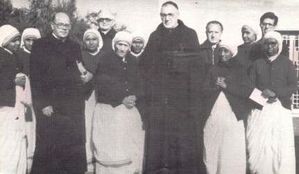
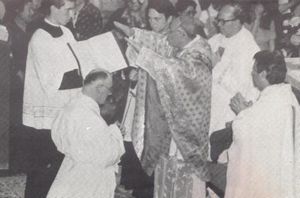
We continue here the biography of Brother Gino Burresi. O.M.V., which started in Issue 9-10 of The Fatima Crusader. Brother Gino's Shrine of Our Lady of Fatima at San Vittorino near Rome, Italy, has become internationally well-known, and people from all over the world come to visit Brother Gino and come to his Shrine as a place of prayer and pilgrimage. Many people feel they have received special graces through Our Lady's intercession there. Brother Gino has attracted many young people to San Vittorino to live the life of consecrated religious. These young people, mostly from the United States and Canada, have accepted the call to follow Christ and His Blessed Mother together with Brother Gino and the Oblates.
We continue here the description of the Oblate spirituality to which his young seminarians are attracted.
A special emphasis is given to adoration of the Eucharistic Lord, and this practice provides the Oblates with a major source of their spiritual strength and apostolic zeal.
Brother Gino by his words and example is true to the aims of the founder of his order. The first aim of the Oblates of the Virgin Mary is the salvation and sanctification of its members by imitating the virtues of Jesus and Mary. The second aim is the salvation and sanctification of others. Brother Gino constantly recommends loyalty to the Holy Father as the Vicar of Christ, as did Father Lanteri, who compared the Holy Father to a spiritual "prism through which is shed the light of Christian truth." Brother Gino directs souls to pray the Rosary and to practice devotion to Our Lord present in the Holy Eucharist.
Teaching Catechism
In his earlier years as a brother, Brother Gino taught catechism to children at St. Michael's Parish in Pisa. He taught in simple, humble, direct language that children understand. His soul was penetrated with Faith and love of God and of the Blessed Mother, and the children were aware of this and so they learned to have a similar faith and charity. They learned of the reality of Our Eucharistic Lord by watching their teacher's example as Brother Gino genuflected before the Real Presence of Jesus in the Most Blessed Sacrament. His spirit of love and adoration in prayer before the Blessed Sacrament communicated much more to the children and youth of the parish than the words of a book could have done.
In Pisa and in other towns where he was sent, he dedicated himself to helping the poor. He also had the responsibility of cleaning the rooms of students who were in residence at the university in Pisa. The students were easily attracted by the ways of the world, and often put God out of their minds. Brother Gino used opportunities when cleaning the students' rooms to meet these young men and to talk to them. His kindness and concern for their souls resulted in many conversions among the university students.
A Little Statue of the Madonna
When Brother Gino received news that he was being transferred to Chiavari, the altar boys and the children of the Catechism class, who were all very sad that he was leaving, decided to give him a present. They bought him a little statue of Our Lady of Fatima. All they knew about it was that it represented the Blessed Virgin Mary. Brother Gino himself had not heard about Our Lady of Fatima. His mother had taught him to have devotion to Our Lady of Lourdes. St. Bernadette was canonized by Pope Pius XI on December 8th, 1933, the Feast of the Immaculate Conception. At that time Brother Gino was about one and a half years old. The devotion to Our Lady of Lourdes, also known as the devotion to the Immaculate Conception, had by that time become very popular, and Blandina Burresi instilled in her little boy a great devotion to God's Mother under that title.
When he went to Chiavari, Brother Gino brought with him the little statue of Our Lady of Fatima that the children had given him. He looked for reading materials that would tell him about the story concerning the little statue of Our Lady. At Chiavari he was assigned work in the chapel of the Sacred Heart and janitorial work in the college.
People he came in contact with began to notice his humility and charity and they would ask his counsel and prayers. He had words of comfort for all who came to him, and he invited them to turn with faith to Our Lady of Fatima. With the permission of his superiors, he would go to visit the sick in the nearby Civil Hospital, and bring them words of comfort and invite them to pray and have faith in the maternal intercession of Our Lady. He gave everyone little medals or rosaries or holy cards. Both the patients and the people who worked at the hospital enjoyed and desired his visits. Soon many souls began to tell of special graces they had obtained which they believed were the result of Brother Gino’s prayers. There were cures and conversions which seemed miraculous. At Chiavari, with the help of Our Lady of Fatima, Brother Gino began his special apostolate of conversion of sinners through counseling, direction of good souls and care of the sick. He did these things with great humility and discretion and even his superiors didn't at first realize the magnitude of his charitable works and the great effect he was having on so many souls.
On May 8, 1983 before a congregation of 25,000 people, Brother Gino was ordained to the priesthood. Our readers should note in the following articles Father Gino is referred to as Brother. We did not have time to change the type set for these articles. We are certain that our readers join with The Fatima Crusader in extending our prayerful best wishes to Father Gino on this sacred occasion.
We continue here the biography of Father Gino Burresi, O.M.V., which started in Issue 9-10 of The Fatima Crusader. Father Gino's Shrine of Our Lady of Fatima at San Vittorino near Rome, Italy, has become internationally well known and people from all over the world come to visit Father Gino and come to his Shrine as a place of prayer and pilgrimage. Many people feel they have received special graces through Our Lady's intercession there. Father Gino has attracted many young people to San Vittorino to live the life of consecrated religious. These young people, mostly from the United States and Canada, have accepted the call to follow Christ and His Blessed Mother together with Father Gino and the Oblates.
In 1955 he was sent by his superiors to the community of the Oblates of the Virgin Mary attached to the parish church of St. Helena's in Rome. There he was given the duty of care of the church and cleaning the house. There the people of Rome began to know of his goodness and they brought him things for the poor people whom he helped.
In 1957 the Rector Major (Superior General) called Brother Gino to be near him in the house of the General Curia which is next to the Mammertine prison in the heart of Rome. The Mammertine prison, which is presently in the care of the Oblates, is where two thousand years ago Saints Peter and Paul were instrumental in converting 47 fellow prisoners to the Faith. This happened about a day before Saints Peter and Paul were taken to their places of martyrdom. They had no water in the prison to baptize the converts with, but a miraculous spring came up out of the floor of the prison at the Saints' prayer, and they used this water to baptize the converts. To this day, this spring of water is still there.
Over this prison is built a church dedicated to Saint Joseph the Worker. As Brother Gino's reputation for holiness spread, more and more people came to ask graces through the intercession of the "Madonnina" (the little Madonna). They prayed the Rosary before his little statue of the Madonna of Fatima. The superiors at the Mammertine allowed the little statue to be exposed over a side altar in the church of Saint Joseph.
The Pious Congregation
The numbers of the faithful who were gathering to pray the Rosary at the Mammertine kept increasing, and many went there every day and thus became friends. They wanted to unite in an organization to work more effectively with Brother Gino to make known the devotion to the Madonna of Fatima and Her message. Brother Gino saw how the movement was growing and so he decided to seek approval from the ecclesiastical authority (The Vicariate of Rome) to canonically found the "Pious Congregation of Our Lady of Fatima" for the conversion of sinners.
With the help of Monsignor Crovella, who worked at the Vatican, a rule governing the association was proposed. There was a careful examination of the actions of the faithful in this new group.
The Statutes were officially approved by the Cardinal Vicar of the Holy Father, Cardinal Micara, on Feb. 28, 1958. Thus, through the initial instrumentality of the sacramental of the little Statue of Our Lady of Fatima, the movement grew and won official Church approval. In fact, Pope Pius XII, himself greatly devoted to Our Lady of Fatima, met in audience with Brother Gino and personally blessed the little statue and his work in the Fatima apostolate. At present, only the spiritual aspect of the association remains. They are prayer groups which bring groups of pilgrims to the Sanctuary of San Vittorino. The use that Heaven made of the small statue of Our Lady of Fatima is indeed a lesson in the importance of sacramentals, which are holy things or actions of which the Church makes use to obtain spiritual and temporal favors from God. Unlike Sacraments, the power of sacramentals does not come from the objects themselves, but from the Roman Catholic Church's prayers of intercession.
The Sanctuary at San Vittorino
One day in 1958 or thereabouts, Brother Gino went out to the edge of Rome, to a small village named San Vittorino. He went there to visit a man named Angelo Colista, who was sick. The doctors at the hospital in Rome realized there was nothing that could be done to save his life and they told his relatives to take him home to San Vittorino. Signor Colista relates: "My case moved the town with pity. I had small children, and my death would have left my family in great difficulties.
"Somebody told one of my relatives: 'Why don't you call Brother Gino? He is a religious brother. He lives in Rome and helps poor people. They say he is working miracles.'
"My parents ran to the parish priest. They begged him to go to Brother Gino. The day after, Brother Gino came to see me. As soon as I saw him I said, 'I don't ask to be cured. I am ready to remain an invalid forever, to suffer, but I wish to see my children grow and be able to be their advisor.'
"We prayed together. Brother Gino told me before he left, 'Be confident. Your wishes will be fulfilled."'
Signor Colista adds: "I am not completely cured. But I am still alive, just as I asked. Brother Gino and I became friends. He came to see me often. His visits left such a peace in my soul.
"On one Sunday afternoon, (December 8, 1960, the Feast of the Immaculate Conception), after speaking to me, he went for a walk with my son and the other lads. When they reached that part of the town where there is a chapel dedicated to Saint Rock, Brother Gino said, 'Let us pray the Rosary.'
"They began to pray. All of a sudden an extraordinary thing happened; he had begun to speak alone ..." Brother Gino was oblivious to his immediate surroundings.
Brother Gino came to understand at this time, that Our Lady wanted a church to be built on that spot, dedicated to Our Lady of Fatima. Many people would come to this shrine of Our Lady of Fatima to be converted. He understood that he would have to undergo many sufferings, but that Our Lady would always be near him to help him.
In January 1961 Brother Gino brought a statue of Our Lady of Fatima to the parish church in San Vittorino, and right away the people of the town began to share his enthusiasm for the new sanctuary. In the field chosen for the new church, a little shrine was built, and on May 13, 1961 a small statue of Our Lady of Fatima was placed there.
In 1964 a little crypt church was built there, which is now at the base of a large sanctuary. It is common in Europe to have a smaller crypt church at the base of a larger construction, and this is also the case at the Oratory of Saint Joseph in Montreal, Canada. In the smaller church at San Vittorino is a Statue of Our Lady of Fatima, which came from Fatima, Portugal. An American who visited San Vittorino recounts that in 1972 this statue shed tears. The tears were taken to Rome and analyzed and were found to be human tears. It seems according to that same American, that Brother Gino asked Our Lady why She was crying, and Brother Gino understood that She was sad because the work of the Sanctuary was going too slowly. That was in 1972 but now the sanctuary is nearly completed.
Not long after Brother Gino had understood that Our Lady of Fatima wanted him to build a shrine at San Vittorino in Her honor, the following incident took place, as related by a friend of Brother Gino:
"It was around this time that Brother Gino one day wanted to go to San Vittorino, to see a man about the deed for buying this particular land where the church was to be built. And a friend of his had an old Fiat car. And Brother Gino asked him to take him to San Vittorino in it. And his friend said, "Well, I'm sorry, Brother, but I don't have any gas in the car. It's completely run out. It's bone dry. And I don't have any money, and I know you don't either." And they got into the car, and Brother Gino asked for the keys, and he blessed the keys. And he told the man now to try to start the car. Well, it started, and they drove twenty miles to San Vittorino, and then about twenty miles back to the center of Rome where the Mammertine prison is, where Brother Gino lived. Brother Gino thanked the man for the ride."
FATHER GINO SPEAKS ON THE MESSAGE OF FATIMA
We continue below, the article which begins in Issue Number 9-10, which gives some practical ideas on how to live the message of Fatima today, as explained by Father Gino Buressi, O.M.V., an Oblate of The Virgin Mary, who has built a shrine in honor of Our Lady of Fatima in San Vittorino, Italy. Father Gino's knowledge and understanding of the message of Our Lady of Fatima, and his gift for teaching, have enabled many young people to understand the message that Our Lady of Fatima has for them as individuals, and to answer Our Blessed Mother's call in their own lives.
On May 8, 1983 before a congregation of 25,000 people, Father Gino was ordained to the priesthood. We are certain that our readers join with The Fatima Crusader in extending our prayerful best wishes to Father Gino on this sacred occasion.
We give, in this article, in some detail, words of Father Gino himself, on living the message of Fatima, as he has explained in various writings, conferences, talks and interviews. We are publishing this article with the hope that through it, more people will come to have a better understanding of how to put into practice in their own lives what Our Blessed Mother asks of us at Fatima.
Follow the Pope
In teaching about the message of Fatima, Father Gino indicates to mankind its infallible guide, the Pope, Vicar of the world's Savior, Jesus Christ. Our Lady of Fatima prophesied to the three children about persecution against the Church and particularly against the Holy Father. Little Jacinta saw visions of the Holy Father suffering. She said to her cousin Lucia in 1917, "I don't know how it was, I saw the Holy Father in a very big house, kneeling by a table with his head buried in his hands, and he was weeping. Outside the house, there were many people. Some of them were throwing stones, others were cursing him and using bad language. Poor Holy Father. We must pray very much for him." The message of Fatima reminds us to pray for the Pope and to follow his guidance in matters of faith and morals. Father Gino adds also that it is urgent that the priests be faithful to the Magisterium of the Pope and when guiding souls, they must teach according to the Pope's doctrine taught to the whole Catholic Church.
The Fatima Message Is for Our Times
Our Lady of Fatima warned us that if Her requests were not heeded, Russia would spread its errors throughout the world. One of these errors is to deny the existence of God and Heaven and Hell and our immortal souls, and to live as if material things were our gods. Another error is militant atheism which seeks to destroy Christ and His Church by seeking to destroy the life of Christ (Sanctifying Grace) in our souls, and by open persecution of the Church as occurs in Communist and Marxist countries.
When asked why the Fatima Message is so important for these times, Father Gino replied, "Because in the world there was the great spreading of materialism, and it was just, that from Heaven should come a reminder so that men should pay attention and be careful not to fall into the error of materialism, but rather should strengthen themselves in the Christian life." "It (materialism) is a total destruction of the faith. Now we see why Our Lady has asked for the consecration of oneself to the Immaculate Heart of Mary so that these errors of materialism which have spread throughout the world will not enter into our hearts. Our Lady has given us a way so that our hearts will not open up to embrace this materialism. First, she calls us to prayer and a certain way of prayer: saying the Rosary. If we are attentive in looking around us we see that the modern mentality of materialism and atheism has attacked each one of these ways of salvation which has been given to us. So Our Lady says to pray the Rosary; in our times the Rosary has been attacked." Father Gino also said: "Another thing we should look at is that the message of Fatima has not been heeded to its fullest extent, and we can see around us today the effects of this. Materialism has brought us to a great confusion, and we don't know who to follow anymore. We read about how little Jacinta came to the two other children and said that she had seen a vision of the Pope, who was weeping because no one would listen to the message, because their hearts were no longer open. Therefore, we must listen to the secure guide, who is the Pope. We must not make the Gospel into a political thing, which (error) today is bringing the world to disaster."
Speaking on another occasion about materialism, Father Gino said: "I wish to underline one thing: This materialism is truly an incredible thing. Let the man beware who opens the door of his heart to it. It will kill him. It will bring death into the heart of the man, and it will kill all the life which Christ has brought to him. It has a very cruel goal and that is to bring man lower than an animal. We all must see the need to prevail upon Our Lady to bring about this miracle to destroy the materialism that destroys the commandments of love (love of God and love of neighbor). Man separates them and then does not love any longer. Then he is finished." Father Gino is alluding to the fact that some modern men think that they serve the Gospel by preaching concern for the poor without teaching living the love of God, and thereby these men end up not loving or being concerned for the poor or for anyone, in fact.
Speaking about materialism, Father Gino said "Materialism destroys. It destroys Christ in man and elevates the animal part. It not only takes away the Christian ideals but makes us worse than animals. Materialism includes pampering the body, wanting excessive property, the best of food, giving in to desires of the flesh. This is a freedom which is not a freedom. Actually, you become a slave of all these things, and then you are not even a master of yourself. You become a slave to vice, to carnal vices, the desire to have more than is necessary - one is never content. It is a construction of hell which we create on this earth."
Speaking about the present disbelief in the existence of hell, Father Gino said among the material punishments, Our Lady spoke of the eternal one and that is hell. Nowadays, man laughs in scorn when hell is mentioned. He does not believe it. Yet the Saints all tremble at hearing the word."
"... a world of materialism and atheism seeks to destroy the true life in the heart of man, the life of Christ in us. Without this life mankind finds itself totally disoriented and plunged in darkness, bringing many of our brothers to live in brutal violence and in an immorality that effaces the beauty and the dignity of man."
Father Gino in a letter of Easter 1982 tells us a way to help overcome this problem as individuals: "We who believe in the Risen Christ and who strive to live His glorious resurrection, must do something for these our brothers; and the first thing Jesus asks of us is this: to be ever of good example, especially where we spend the most part of our day.
Conversion of Russia
Our Lady of Fatima promised that if Her requests were granted, Russia would be converted and there would be peace. On this point, Father Gino gave the following helpful advice: "We must also remember another thing. We must pray every day for those who are behind the Iron Curtain, for the conversion of Russia, for the conversion of sinners who do not believe. Our hearts pray as part of the Mystical Body of Christ. We must pray that every individual person, through the intercession of the Blessed Mother, will have the time in which he will be able to hear the call and listen to the message of God."
 |
| Father Gino giving Holy Communion to one of the Sisters of the new religious order that he founded, assisted by one of the many seminarians who have been attracted to San Vittirino by Father Gino. |
How Christ Is Killed in the Modern World and How to Bring About His Resurrection
Father Gino further makes clear how it is that Christ is being crucified again through sins of individuals and nations, and how Catholics, by reason of their membership in the Mystical Body of Christ (which is the Catholic Church) can, by their good deeds and virtuous acts, done for God's sake and performed while in the state of grace, can bring about Christ's Resurrection in the modern world. That is to bring mankind as a whole back into friendship with our Creator. And this is what the Mother of God is trying to teach us through the message of Fatima.
"If we look for a moment at this poor world, we would see that Jesus has been killed in many ways. He has been killed in the maternal womb and many mothers organize new "sanhedrins" so that Christ will be killed in their baby.
Today Christ is killed in the innocents and for this purpose the little ones are taken out of those nursery schools where they are taught to know Jesus. There is only one purpose of the materialists. That is: Put the death of materialism that kills Jesus, into the heart of the child. Christ is killed in the hearts of youth when they are made into instruments of this same materialism and pushed toward hate that ends up in the most cruel violence. Christ is killed in the schools where civility and honesty should be taught, while many times also here they try to lead the children to hatred and violence. Christ is killed in the work environment and we know well how much he who wants to give a Christian testimony is persecuted. Christ is killed in the press, in the cinema, in the theater and in many other environments. In a word, (the purpose of the materialists is that) Christ's commandment of love be killed in the mind and heart of man (and yet the unreflecting materialists do not realize) that man without Christ will be the cause of many tears of sorrow for all."
Father Gino also said: "If you want to hasten the Resurrection in all environments where Christ is killed, we Christians and devotees of the Madonna must respond to the satanical attack of so much evil with the armor of goodness and charity of the Gospel, pray for them, offer sacrifices for them. Start saying the Holy Rosary for them, accept all which God would send our way, even if it makes us suffer. To suffer well, this also means to love; it is an act of love for God when I accept suffering to repair first of all my failures, and it is a true act of love of God and of my neighbor when I offer this suffering in particular for the return of these poor brothers blinded by the same materialism that they accepted. This is none other than the message of Fatima. Respond to the message of hate with the message of love."
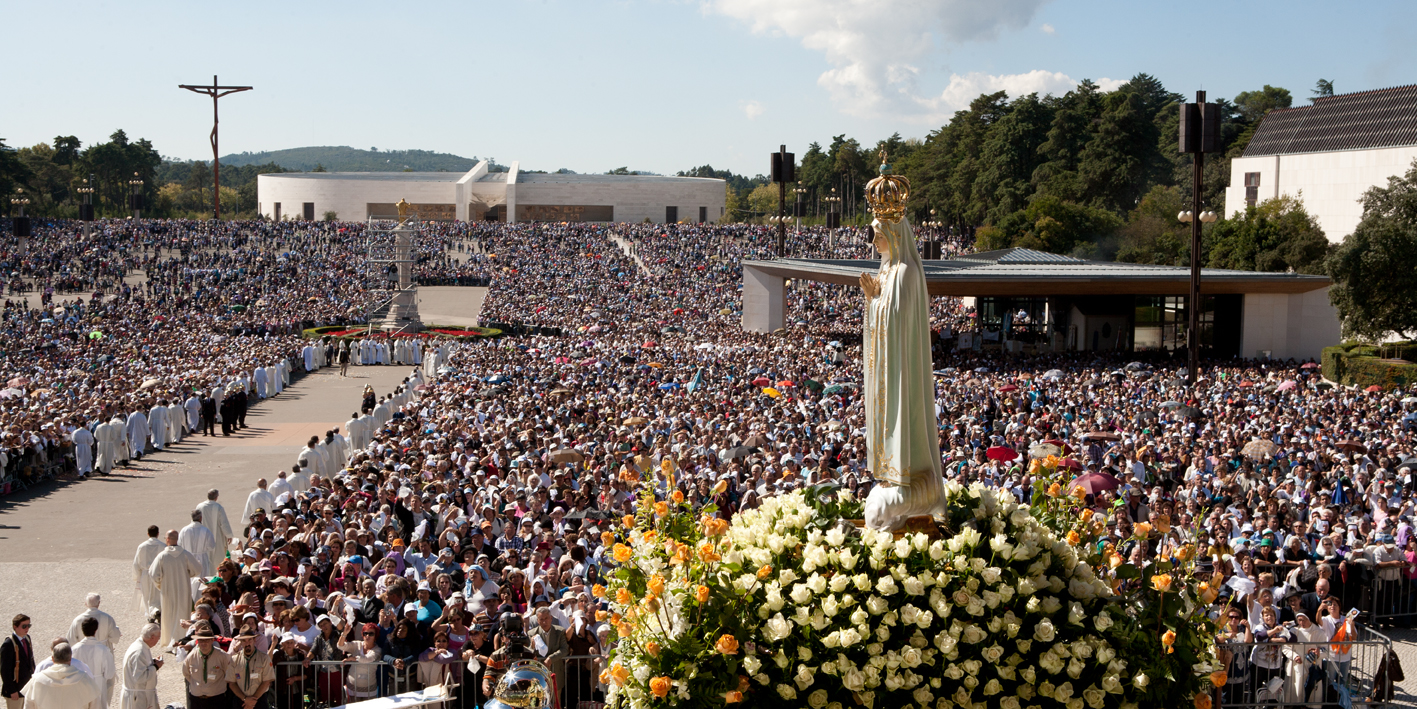
 inundado por um mistério de luz que é Deus e N´Ele vi e ouvi -A ponta da lança como chama que se desprende, toca o eixo da terra, – Ela estremece: montanhas, cidades, vilas e aldeias com os seus moradores são sepultados. - O mar, os rios e as nuvens saem dos seus limites, transbordam, inundam e arrastam consigo num redemoinho, moradias e gente em número que não se pode contar , é a purificação do mundo pelo pecado em que se mergulha. - O ódio, a ambição provocam a guerra destruidora! - Depois senti no palpitar acelerado do coração e no meu espírito o eco duma voz suave que dizia: – No tempo, uma só Fé, um só Batismo, uma só Igreja, Santa, Católica, Apostólica: - Na eternidade, o Céu!
inundado por um mistério de luz que é Deus e N´Ele vi e ouvi -A ponta da lança como chama que se desprende, toca o eixo da terra, – Ela estremece: montanhas, cidades, vilas e aldeias com os seus moradores são sepultados. - O mar, os rios e as nuvens saem dos seus limites, transbordam, inundam e arrastam consigo num redemoinho, moradias e gente em número que não se pode contar , é a purificação do mundo pelo pecado em que se mergulha. - O ódio, a ambição provocam a guerra destruidora! - Depois senti no palpitar acelerado do coração e no meu espírito o eco duma voz suave que dizia: – No tempo, uma só Fé, um só Batismo, uma só Igreja, Santa, Católica, Apostólica: - Na eternidade, o Céu! 
